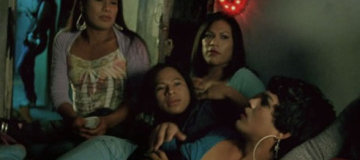
The ethics and aesthetics of queer films directed by Latin American women
On Thursday 3rd November 2022, 5.00 p.m., we invite you to join the second event in the "Conversazioni a Casa Cornaro 2022/23" talks series on The ethics and aesthetics of queer films directed by Latin American women.
Our guest will be Lucía Gloria Vázquez-Rodríguez, Master's degree in Film and Philosophy from King's College London and PhD in Audiovisual Communication from the Universidad Complutense de Madrid. Since 2016, she has been teaching and conducting research on queer cinema and TV, feminist media studies and Women's cinema, areas in which she has published several articles and book chapters. She also collaborates in the coordination of the MA in LGBTIQ+ Studies at the same university, and is a member of the GECA Research Group (Gender, Aesthetics and Audiovisual Culture) and of the UNESCO-UNITWIN Network on Gender, Media & ICTs.
Chair: Claudia Padovani (University of Padua).
The event will take place at the Elena Cornaro University Centre headquarter in Via Martiri della Libertà 8, Padova (second floor).
Those who cannot attend in person can follow the event online on Zoom at this link: https://unipd.zoom.us/j/81682121723.
---
ABSTRACT
In the past twenty years, there has been a significant increase in the number of Latin American women filmmakers whose works focus on queer desires, non-normative sexualities and "deviant" bodies. The films of Lucrecia Martel, Lucia Puenzo or Claudia Llosa not only tackle issues related with sexual (dis)orientation, forbidden desires and non-hegemonic gender identities, but also have a recognisable, "feminine" style in which tactility, haptic images and the child's perspective help deactivate the distance, domination and voyeurism generally associated with the cinema of the Male Gaze (Mulvey, 1975). In this sense, the concept of "the haptic" developed by Laura Marks (2002) has proved to be particularly relevant for the analysis of the corpus as a theoretical alternative to the dominating feminist film theory of the Male Gaze developed by Mulvey in the 1970s; these Latin American women filmmakers fill their works with tremendously sensual images, images of touch, smell, and sweat, images of textures, bodies and taste: in two words, haptic images. As Luce Irigaray remarks, "woman takes pleasure more from touching than from viewing" (1977: 25). Therefore, by privileging and embodied approach to cinema, these productions invite the viewer to establish an intersubjective, ethical relationship with the image, epitomized in the non-dominant, respectful attitude of their child protagonists towards the (racial, gendered, sexual) Other.
Through texturized, sensual images - water is a common element in all these films, suggesting disorientation and acting as a metaphor for the fluidity of the protagonist's sexual identities (Ahmed, 2006) - these filmmakers bring the viewer closer to the image, thus challenging patriarchal understandings of the Gaze, relinquishing their mastery over the image, so subjective limits become blurred in an osmosis of corporeal sensations. The spectator, too entangled with the image – feeling it with their skin, with their muscles (kinaesthetically), and with their viscerae – cannot take a step back in order to discern (sexual) difference. That is the reason why the political potential of these films for representing the queer cannot be underestimated; by bringing us closer to the sensual experiences of this dreaded Other (seen as a threat for our identity), we feel with them, experiencing the film with the same tactile fascination that they have toward their world, so the limits between the I and the non-I disappear, such embodiment enabling us to empathise with these (intersexual, indigenous, queer) bodies that we can no longer see as Other.





